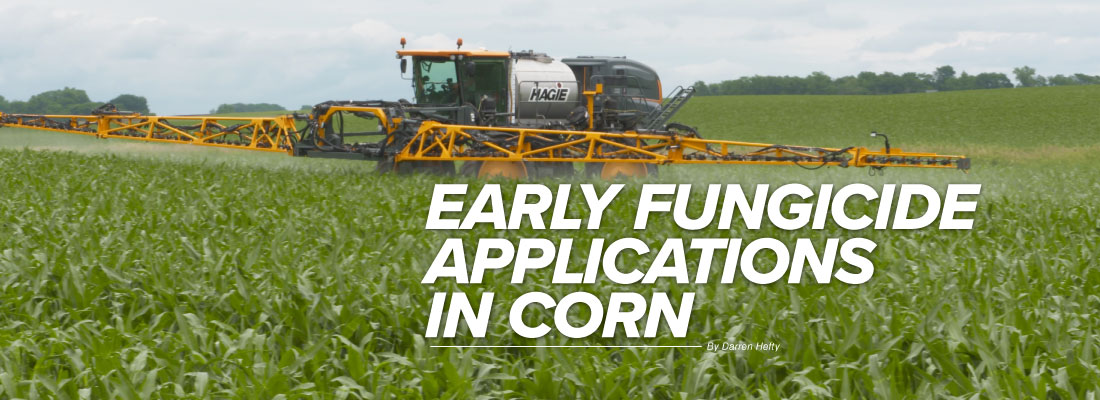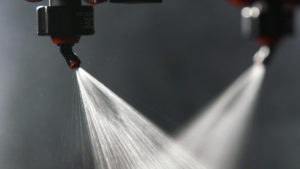
I get questions every year from farmers asking, “Is this a year V5 fungicide will really pay in corn?”
There’s no way of knowing if this year will be the best year ever for fungicide application or the worst, so you’ve got to play the averages. Depending on whose data you want to look at, there’s some yield protection for corn, but the following are some situations where you will usually see the best return on investment (ROI).
- CONTINUOUS CORN
- REDUCED TILLAGE OR NO-TILL
- IRRIGATED FIELDS
- EXTENDED TIME WITH WARM AND HUMID CONDITIONS AND HEAVY DEW
- PAST HISTORY OF DISEASE ISSUES
- HYBRID WITH LOW LEVEL OF DISEASE TOLERANCE
- HIGH YIELD POTENTIAL
- LOW COST OF TREATMENT
Those first conditions may vary from farm to farm, but the last one is available to everyone, especially in the early application timing around V5 corn (give or take a couple leaves). At this stage, you can still run your ground rig over the field, and you may be doing so to apply a herbicide treatment already. If that’s the case, then the fungicide could be getting a “free ride” over the field. This greatly lowers the amount of yield gain you need to get a great ROI.
This year, the price of fungicides has come down, as well. Some companies like BASF have just straight up lowered the prices on great products like Priaxor. In other cases like the Bayer Plus program, excellent products like Stratego YLD may be as low as $2-3 per acre if this is your fourth or fifth Bayer product for the year. Find more rebate details on their website or by visiting with your agronomist.
At this spray timing the plants are still relatively small. The recommended use rates are roughly half what the rates are at tassel, so that helps keep the costs down, too. For example, Priaxor is often used at 2 ounces and Stratego YLD at 2.5 ounces around V5. There are many different, effective, multiple mode of action fungicides out there. These are just a couple well-known examples.
Focus on ROI
If application is free or a minimal cost ($2-3/acre to run your own sprayer), and high quality fungicide could be sourced for as little as $2-3/acre after rebates, even if the corn price is not great (let’s use $3 as an example) you’d only need 1 to 2 bushels to break even on the treatment and 3 to 6 bushels to triple your money!
MAKING IT REALLY WORK
Prevention, not cure.
Fungicides provide disease protection on leaves they are sprayed directly on in advance of disease outbreaks.
Certain fungicides can also provide the plant health benefits of:
Serving as antioxidants
Reducing ethylene (stress hormone that causes premature death)
Increased photosynthesis
Lower temperature in the plant

The angled spray pattern of Pentair-Hypro 3D nozzles provide improved coverage needed in fungicide applications.
Coverage is key.
Fungicides only protect the leaves they are sprayed on. Use tips that produce smaller droplets like the Hypro 3D nozzles. Check to see which leaves are being covered by the spray and adjust water volume and pressure accordingly.
Later may be better.
Many companies say the window for early corn fungicides is from V4 to V7 (four to seven leaves with fully-developed leaf collars). If you can target V7 or possibly even later, you could get spray coverage on the ear leaf, which is an important leaf for yield determination.
Adjuvants.
It’s fine to use a spray adjuvant up to V7. However, between V8 and VT (tassel) DO NOT USE AN ADJUVANT, as it could drive the product into the plant too quickly causing stress that could lead to arrested ear development.
KEEP IN MIND YOU MAY STILL NEED TO SPRAY FUNGICIDES LATER FOR DISEASE PROTECTION.
- Fungicides generally offer two to three weeks of protection on the leaves they cover. New, unprotected leaves come out each week.
- Diseases like gray leaf spot and northern corn leaf blight over-winter in crop residues and take time to develop spores. Then, it takes some more time for them to move up the plants.
- It will get warmer and certainly more humid as the canopy closes, making conditions more ripe for disease development as the season progresses.
